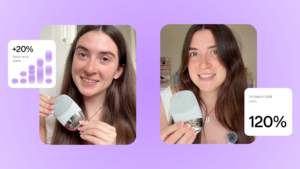From Brief to Breakthrough: Translating Data Insights into Creative Concepts
Passionate content and search marketer aiming to bring great products front and center. When not hunched over my keyboard, you will find me in a city running a race, cycling or simply enjoying my life with a book in hand.

Marketing performance rises and falls on creative quality, but most teams don’t consistently connect platform metrics to what gets briefed.
This post turns your data into creative concepts you can actually produce. By showing how Billo’s data‑backed briefs translate Hook Rate, CTR, and ROAS into clear choices for openings, proof, and CTAs.
You’ll learn how to keep your brand voice while applying data‑backed briefs for ideas that scale.
TL;DR
- Align each brief to one primary metric goal.
- Map metric to move using ABCD tactics.
- Prioritize hooks that earn the first seconds.
- Use proof and offers to lift ROAS.
- Pair Billo Brief Builder with platform benchmarks.
The metrics that matter: Hook, Retention, CTR, ROAS
The right metrics tell you what to fix first so your creative concepts don’t chase noise. Think of Hook, retention, clicks, and efficiency as a simple chain: earn attention, hold interest, invite action, and prove value.
Hook Rate is your early attention proxy. When a higher share of viewers watch the first seconds, the opening of your creative concepts is working and more people will see the value moment.
On Meta, “3‑second video plays” flag whether the opening beat stops the scroll, and “ThruPlay” shows if the middle keeps people engaged long enough to understand the offer. Average video CTR sits near 1.3 percent, which makes clarity on the end frame essential if you want to beat baseline.
On TikTok, a 2‑second view filters drive‑by scrolls, while a 6‑second Focused View credits either 6 seconds watched or one interaction in the first 6 seconds. Optimizing for Focused View is a useful way to judge short‑form salience before you ask for the click.
Map metrics to goals
Use Hook Rate and Focused Views when the aim is reach and recall. Use CTR and ROAS when the aim is response, supported by ThruPlay or Focused View times click rate to confirm that interest carried into action.
What to change when results lag:
- Weak Hook or 3‑second plays: rewrite the first line, add immediate motion, and introduce a light brand cue within 3 seconds.
- Soft mid‑view retention or ThruPlay: add a before‑after re‑hook and sequence 2 to 3 proof beats.
- Low CTR versus the 1.3 percent baseline: surface price or guarantee earlier and make the CTA spoken plus on‑screen.
- ROAS slipping despite stable CTR: tighten targeting of the value proposition and pair the offer with visible social proof.
For a deeper breakdown of how these signals inform openings, proof blocks, and CTAs, see Billo’s data‑backed briefs.
From metric to move: Interpreting briefs by optimization goal
Great briefs translate metrics into production choices so creative concepts align with the outcome you need. Use this section to decide what to change in openings, proof, and CTAs based on whether you’re aiming for awareness or revenue.
1. Awareness optimization
Prioritize first‑second impact to raise Hook Rate and early views. Keep branding quick and clear so creative concepts stay memorable without slowing the scroll.
ABCD for awareness
- A – Attention: Pattern‑interrupt in frame 1 with motion, contrast, or an unexpected line.
- B – Branding: Show a light brand cue in the first 3 seconds without blocking the story.
- C – Content: Tease the benefit fast with one visual proof beat.
- D – Direction: Soft prompt like “watch how” instead of a hard sell.
Brief moves when awareness lags
- Replace the opener with a tighter curiosity hook or bold visual change.
- Compress intros; remove slow ramps and repeat the value cue by second 3.
2. Consideration optimization
Strengthen mid‑section sequencing to lift ThruPlay and completions. Build credibility so creative concepts feel useful, not ad‑like.
ABCD for consideration
- A: Re‑hook at second 3–5 with a quick before‑after beat.
- B: Use packaging or creator mention as a lightweight brand reminder.
- C: Add 2–3 proof points like demo steps, social proof, or a mini test.
- D: Nudge to “see results” or “hear the verdict” before the end card.
Brief moves when consideration lags
- Insert step‑by‑step demo beats and cut filler transitions.
- Add a credibility cue like UGC testimonial, rating overlay, or outcome metric.
3. Direct‑response optimization
Make the value proposition explicit to improve CTR and ROAS. Guide the viewer with unmistakable next steps so creative concepts convert.
ABCD for direct response
- A: Lead with the sharpest problem‑solution statement.
- B: Keep brand visible near pricing or offer frames for trust.
- C: Show social proof near the offer, like star ratings or quick quote.
- D: Clear CTA with time‑bound offer and on‑screen button text.
Brief moves when response lags
- Tighten headline, surface price or guarantee earlier, and restate benefit near the CTA.
- Swap a generic end card for a creator‑spoken CTA plus clickable text.
Turning insights into briefs: a step‑by‑step template
Looking to apply the theory in practice? Follow the steps to keep creative concepts aligned to a single goal, then use the template to standardize how openings, proof, and CTAs are chosen.
Step‑by‑step workflow
- Set the objective and choose one primary metric. Tie awareness to Hook Rate or Focused Views, and direct response to CTR or ROAS.
- Pull recent learning. Capture best and worst hooks, top comments, and any creator or format outliers tied to your creative concepts.
- Diagnose the bottleneck. Decide whether the opening, mid‑section proof, or CTA framing is limiting results.
- Choose the ABCD moves. Attention and Branding for awareness; Content sequencing and Direction for response‑driven edits.
- Specify assets and constraints. List must‑show visuals, offer rules, claims approvals, and on‑screen text requirements.
- Plan tests. Define one variable per variation so creative concepts isolate learning across hooks, proof, or CTA.
Copy‑ready brief template
Title: [Campaign / Product] — [Goal]
Objective & primary metric: One sentence on the outcome and the single KPI.
Audience & problem: Who it’s for and the pain you solve in simple language.
Hook angles (pick 1): 3 short options in plain words, no jargon.
Visual ingredients: Opening shot, movement, and product framing to support the hook.
Proof blocks: Demo steps, testimonial snippet, rating, or before‑after you will show.
Offer & CTA: Price, incentive, or guarantee and the exact on‑screen CTA text.
Brand & legal: Logo usage, packaging moments, disclaimers, and claim limits.
Variations: What single variable changes across V1, V2, V3.
Deliverables & specs: Aspect ratios, length, captions, and end‑card requirements.
Measurement plan: How success is judged and when to review.
Tip: Get immediate answers to the industry trends with Billo Brief Builder. Easily translate metrics into clear hook, proof, and CTA choices.
Applying the template: example edits for awareness, consideration, and conversion
Use these examples to turn data-driven suggestions into creative concepts you can brief in minutes. Each scenario highlights the hook, proof blocks, and CTA moves most likely to move the chosen metric, with links to Billo resources for repeatable workflows.
5.1 Awareness example – New product launch
Goal: lift Hook Rate and early views so more prospects learn the core value.
Edit the opener
- Start with motion and contrast in the first 3 seconds, then reveal benefit within 6 seconds.
- Add a light brand cue by frame 4 to 6 to build recall without slowing the scroll.
Proof beats
- One quick demo cut that visually answers “what is it and why it matters.”
- On‑screen text supports the benefit in 6 words or fewer.
CTA framing
- Soft prompt like “watch how it works” to keep attention flowing.
- Close with brand memory, not a hard sell.
Use Billo’s data‑backed briefs to standardize hook angle, brand cue, and first‑seconds pacing across edits.
5.2 Consideration example – Education/demo
Goal: raise ThruPlay and completions by clarifying steps and outcomes.
Edit the structure
- Sequence 2 to 3 demo steps with tight cuts; label each step clearly.
- Re‑hook at second 3 to 5 with a before/after or creator reaction.
Proof beats
- Use a creator voiceover plus on‑screen captions for accessibility.
- Add a quick testimonial line or rating overlay near the outcome moment.
CTA framing
- Nudge with “see it in action” to carry viewers into the end card.
- Keep the brand visible but secondary to utility.
5.3 Conversion example — Promo/offer
Goal: improve CTR and ROAS by making value obvious and action easy.
Edit the value message
- Surface price, discount, or guarantee early so the offer primes the click.
- Pair the value with social proof near the CTA for trust.
Proof beats
- Show star ratings or a one‑line customer quote next to the offer frame.
- Keep product in hand or in use to maintain relevance.
CTA framing
- Use creator‑spoken CTAs plus clickable on‑screen text.
- Write benefit‑first prompts like “see how it fits” or “get yours today.”
Avoid vague briefs that hide the audience or CTA. Share this checklist with your team: UGC brief mistakes.
Checklist: from insight to edit
- Name one primary metric and pick the matching brief type.
- Lock the opening beat, one proof block, and one CTA line.
- Limit each variation to a single variable so you learn which creative concepts actually move the metric.
Proving lift: Testing cadence and pivot rules
Consistent testing turns insights into repeatable wins. This section lays out a lightweight cadence, clear win/loss criteria, and pivot rules so your creative concepts compound rather than reset each sprint.
Weekly testing cadence
- Plan: Lock a single metric target and 1 variable to test across variants.
- Produce: Ship 2 to 3 variants per brief so results isolate the variable.
- Publish: Launch at consistent budgets to avoid skew.
- Pause/Promote: Evaluate at a fixed checkpoint and re‑allocate to winners.
Win/loss criteria
- Winner: Beats your rolling baseline for the primary metric with stable spend.
- Keeper: Matches baseline while revealing a new angle worth iterating.
- Loser: Trails baseline after sufficient spend and shows no upward trend.
Pivot rules
- If openings underperform, rewrite the first 3 seconds before touching proof.
- If mid‑view retention dips, add or reorder proof blocks.
- If clicks stall, move the value cue earlier and rewrite the CTA frame.
Guardrails
- Keep audience, placement, and budgets constant while testing creative concepts.
- Track secondary metrics like frequency and comments only to explain outcomes.
- Document exclusions so outliers do not pollute the baseline.
Naming and logging
- Use a standard name: Campaign_Goal_[Hook|Proof|CTA]_Variant.
- Log hook angle, proof assets, CTA text, and the single variable.
- Capture notes on comments and saves to inform future creative concepts.
Learning loop
- Roll the winning element into a new brief and test the next variable.
- Retire themes that fail 2 sprints in a row and archive learnings for the team.
Note: No additional external or internal links were provided for this section in the Research output; anchors can be inserted if sources are supplied.
Summary
Turning platform signals into creative concepts doesn’t require guesswork. Anchor each brief to one metric, pick the ABCD moves that address the bottleneck, and ship tight variations so learning compounds.
Use the template to standardize hooks, proof blocks, and CTAs, then scale what wins. Pair your process with Billo’s data‑backed briefs, Billo IQ, and this checklist on UGC brief mistakes to keep creative concepts consistent across teams.
Ready to turn your data into ads that perform?
Share this framework with your team, spin up three briefs using the template, and schedule a weekly review to lock winners and retire laggards. When you’re set, brief your next batch with Billo to move from brief to breakthrough.
FAQs
What’s the difference between Hook Rate and Focused View?
Hook Rate is a custom attention proxy, typically early views divided by impressions, used to judge the opening’s pull. Focused View is TikTok’s official 6‑second attention objective that credits either 6 seconds of watch time or one interaction in the first 6 seconds.
Can the same creative serve multiple brief types?
Yes, but edit each version for a single goal so signals don’t conflict. A hook‑optimized cut may differ from a CTR‑optimized cut even if they share the same footage.
How often should brief types be rotated?
Rotate every 4 to 6 weeks or when ROAS variance exceeds 15 percent across cycles. Earlier pivots are warranted if fatigue appears despite stable hook and CTR.
Does creator matching matter more than script?
For UGC ads, authentic creator fit strongly influences hook performance. The source in the research notes a ≈60 percent contribution to hook success, but a supporting link was not provided in the brief, so please supply or confirm the citation before publishing.
SEO Lead
Passionate content and search marketer aiming to bring great products front and center. When not hunched over my keyboard, you will find me in a city running a race, cycling or simply enjoying my life with a book in hand.

Authentic creator videos, powered by real performance data
22,000+ brands use Billo to turn UGC into high-ROAS video ads.
From Guesswork to Growth: A Practical Creative T...
Ad-hoc creative testing often produces noisy results. When multiple variables [...]...
Read full articleTesting Ad Variations: How to Consistently Lift ...
Most performance gains come from better creative, not targeting tweaks. [...]...
Read full articleAI‑Driven Creative Coaching: How Machine Learn...
Creative is no longer just a variable – it’s the [...]...
Read full article



